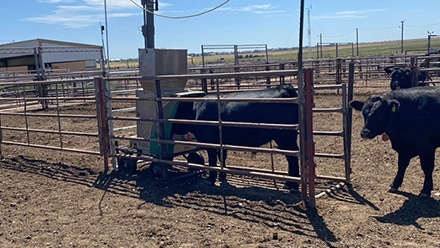Research also suggests that grain processing can increase economic return of a feedlot by increasing feed and nutrient use efficiency.
June 13, 2022

According to the U.S. Environmental Protection Agency, agriculture accounts for about 10% of America's greenhouse gas emissions, and enteric (intestinal) emissions and manure management account for about 27% of that. Scientists at the USDA Agricultural Research Service's Conservation and Production Research Laboratory in Bushland, Texas, recently took up a challenge to estimate how cattle feeding can knock methane numbers down. In a twist on the theory that 'what goes up must come down,' they examined how 'what goes in must come out.'
"The most common grain fed to cattle is corn, which is typically processed to increase the availability of starch for ruminal fermentation," says Matt Beck, ARS animal research scientist. "The process of steam-flaking corn produces greenhouse gas. But, if steam-flaked corn can reduce methane emissions from cattle to a great enough degree, feeding it to cattle may still be more environmentally friendly than feeding them other grains."
In short, they evaluated whether two processes that produce greenhouse gas – steam-flaking corn and feeding it to cattle – could together create less total gas than the current corn feeding alternative: two negatives leading to a positive result.
By combining an animal feeding trial and a Life Cycle Analysis approach to estimate the carbon footprint of cattle production, the research team determined that feeding steam-flaked corn to cattle reduced enteric methane emissions by 21% compared to feeding them dry-rolled corn, another common feedlot staple. The process used to steam-flake corn produced 9.7 times more greenhouse gas than dry-rolling, but it reduced animal emissions so much that the total carbon footprint of steam-flaked corn was 9-13% less than dry-rolled corn.
"Steam-flaking corn for rations in the feedlot decreases methane emissions, even when accounting for the additional energy required," Beck says.
"The research also suggests that grain processing can increase the economic return of a feedlot by increasing feed and nutrient use efficiency," he says. "That's a win-win opportunity for both society and producers. Mitigation options that also provide economic incentives are, most likely, the ones that will be implemented and used by producers."
Source: USDA ARS, which is solely responsible for the information provided, and wholly owns the information. Informa Business Media and all its subsidiaries are not responsible for any of the content contained in this information asset.
About the Author(s)
You May Also Like
.png?width=300&auto=webp&quality=80&disable=upscale)

.png?width=300&auto=webp&quality=80&disable=upscale)
